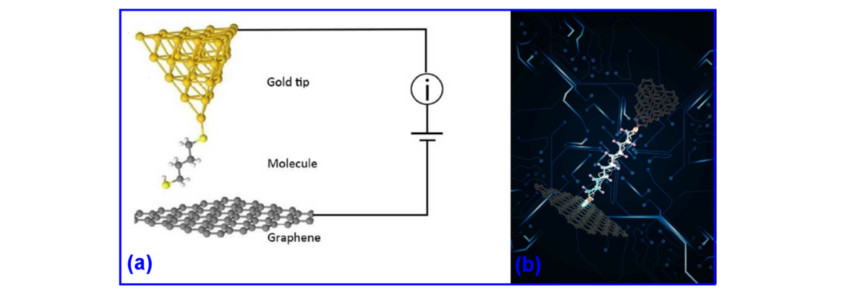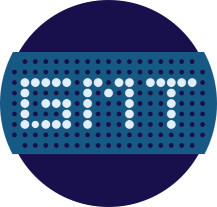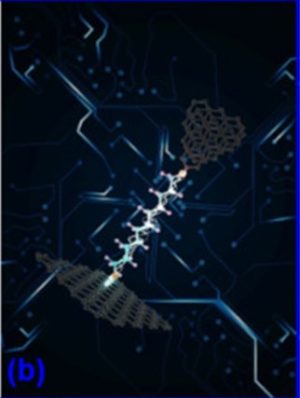A nearly 10-year long, strong international research collaboration between Prof. Li Yang from School of Science at Xi’an Jiao Tong Liverpool University and Dr. Yannick Dappe, senior researcher at Condensed Matter Physics Laboratory (SPEC – CNRS, CEA Saclay, France) has led to many productive outcomes.
In 2015, Prof. Li Yang was starting experiments in Molecular Electronics, using for the first time (it was not really common at that time) graphene electrodes as a counter electrode in scanning tunnelling microscopy (STM) molecular junctions. Dr. Yannick Dappe already had some good experience in Density Functional Theory (DFT)-based electronic transport calculations in particular to model STM experiments. For example, at that time he already developed a theoretical model to describe a full carbon molecular junction.
The project aimed to work on alkane-based molecular junctions with thiol anchoring groups and to compare the electronic conductance between standard molecular junctions with two gold electrodes and hybrid molecular junctions with gold and graphene electrodes, as illustrated in Figure 1 (a). In particular, Prof. Li Yang and Dr. Yannick Dappe considered the conductance evolution as a function of the molecular length in order to determine the attenuation of the electronic current in the junction. As a result, they observed an interesting phenomenon, they noted that while the contact resistance is more important in hybrid molecular junctions, its electronic current attenuation is much less important compared to the standard gold-gold configuration. In other words, it is possible to conduct more current for longer molecular chains using a graphene electrode. The combination of experimental data and electronic transport calculations allowed the interpretation of this result, first as an electrostatic dipole effect due to the weak interaction at the graphene interface, and later more generally as a symmetry breaking effect due to the insertion of a graphene electrode.

Figure 1: (a) Schematic illustration of a hybrid gold-molecule-graphene molecular junction (b) Artistic representation of a full carbon molecular junction
This very firstfinding, was published in Nano Letters and established the groundwork and foundation of a strong, productive and long term collaboration. From then on, Prof. Li Yang and Dr. Yannick Dappe have developed a full research line on graphene electrodes in molecular junctions, analysing the influence of the different parameters of the system on the electronic current attenuation. Through various experiments and theoretical models, they have considered the influence of the anchoring groups, including asymmetric junctions with different anchoring groups, the molecular backbone, revealing that for some specific molecules there is no influence of the graphene electrode, or the electrode metal. They have even reproduced experimentally the model of full carbon molecular junction previously developed by Dr. Yannick Dappe, as illustrated in Figure 1(b).
From 2017, Dr. Yannick Dappe also started to visit regularly XJTLU for at least two weeks once a year. During these visits, he has given several seminars at the Chemistry Department and lectures to Prof. Li Yang’s group in Molecular Electronics in order to give them the basic theoretical concepts in the field, and support their experimental comprehension. As such, he started to co-supervise PhD students with Prof. Li Yang and helped in conceiving and designing new experiments. In 2019, Dr. Yannick Dappe was appointed as Honorary Lecturer in the Chemistry Department for three years, in recognition of his valuable contributions and to further strengthen the research collaboration, co-supervise students and delivery of seminars.
Unfortunately, from 2020, due to the pandemics, the visits to XJTLU were suspended, but the scientific collaboration still went on. In particular, new lines of research were successfully initiated, for example on electrochemistry-STM aiming at conceiving and developing new models of molecular transistors, on quantum interferences in molecular junctions and on large-area self-assembled monolayers molecular junctions.

Figure 2: (left) The seminar given by Dr. Yannick Dappe to the research group (right) Project discussions with the PhD student
In 2024, the physical visits to XJTLU have resumed, which will strengthen the collaboration in view of building stronger relationships between the acclaimed institutions of Prof. Li Yang (XJTLU, China) and Dr. Yannick Dappe (SPEC – CNRS, CEA Saclay, France). This nearly 10 years long collaboration has already led to the publication of 13 scientific articles in prestigious scientific journals and the co-supervision of 3 PhD thesis to completion. For this year, 2 other PhD thesis will be defended and it is envisaged that it will lead to the publication of 4 scientific articles. Now new scientific projects are on the way, as well as the possibility for student exchange, to further structure and support the development and growth of this important and fruitful collaboration, with ambition for very high scientific perspectives. The future looks bright!
Material provided: Professor Li Yang (avril 2024)
Contact: Yannick Dappe, SPEC/GMT





